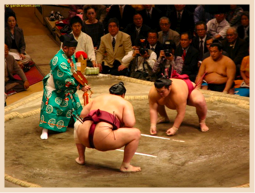
Todd Jay Leonard, Blog


When a friend from Shelbyville recently visited me, it happened to be during one of the regularly scheduled Sumo Grand Tournaments. Each day she sat mesmerized in front of the television, watching with great anticipation who would win the bout and who would ultimately lose. After only a few days, she had figured out the rules and was rooting for her favorite players.
This reaction to sumo wrestling is typical of visitors to Japan. There is something very absorbing about the national sport of Japan that hooks people after just a couple of hours of watching it.
Each new season brings a grand tournament, which packs the stadium where the bouts are held and has office workers huddled around their office televisions to watch the outcomes of the bouts of the higher-ranked wrestlers. Although the bouts usually last a matter of a few seconds, it is very exciting to watch.
Part of the attraction is the history of the sport, dating back some 2,000 years. It is highly ritualized, reflecting an aesthetic art form of ancient Japan that has been passed down over the millennia, retaining many of the same aspects and traditions today as it did then.
Japanese people absolutely love sumo and consider it to be a living national treasure. The top wrestlers who reach the rank of "yokozuna" are treated like superstars. Magazine and television advertisements feature the popular wrestlers. Memorabilia, similar to other sports, feature wrestlers' likenesses on towels, cards, posters, T-shirts and any other imaginable type of souvenir.
Unlike most sports, however, sumo stardom brings with it a huge social and cultural responsibility that is steeped in tradition and proper etiquette that dates back to its beginning. Having dignity and respect for the sport and what it stands for is of utmost importance to the wrestlers ... and to the spectators.
No matter how strong or powerful a wrestler is, without a certain air of dignity that is associated with champion wrestlers of the highest rank, a wrestler will not be promoted to the rank of "yokozuna."
This is what sets sumo apart from other major sports around the world. A wrestler's success is not solely dependent upon his ability but on the whole package of how he is able to conduct himself with respect to sumo and its long history of codified rituals; all of this is in addition to his adroitness in the ring.
Sumo is considered to be a "living museum" of a bygone era because of its rituals and traditions. In some ways, it is more of a performance than a sport. A fan is transported during each bout to a time that is reminiscent of Edo Period Japan (1600-1868).
In the 15th century, sumo wrestlers were used to help train samurai. To fall in battle meant instant death, so to muster the strength and dignity to get up after falling was an embodiment of the sumo ethic, one that served samurai warriors well. Conquering physical exhaustion, staying on your feet no matter what and getting up after falling are lessons that are still taught to young sumo wrestlers today.
Sumo practice is hard. Wrestlers' entire lives and daily routines are centered on sumo. They eat, breathe and sleep sumo during the entire time they are training and wrestling, just as their predecessors have done for hundreds of years.
A wrestler's day begins at 4 or 5 a.m. for the youngest or lowest ranked wrestlers. They must ready the ring for the day's practice and exercise to get loosened up for the pummeling they will most certainly endure from the higher ranked wrestlers.
Physically, the young wrestlers must learn balance, flexibility, and agility - the three essentials for success in the sumo ring. The goal is to have extremely powerful thighs and a very low center of gravity.
When most people think of sumo, the image is of gargantuan men with neatly combed topknots, stomping their feet one at a time from a high position. This exercise is called "shiko," and young wrestlers do this at least 500 times a day. They also sit with their legs spread far apart, leaning down until their stomach and face touch the ring ... not an easy feat to achieve with a huge belly of fat in the way. Not to fear, older wrestlers help the younger ones by standing on their backs to help get the needed flexibility. A painful, but effective technique.
In time immemorial, legend has it that territorial disputes were sometimes settled through sumo bouts. The "will" of the gods decided the outcome, so people would accept success or defeat. This is a much more peaceful and less bloody way to settle disputes, much better than the "shock and awe" methods of modern warfare today.
By TODD JAY LEONARD
Columnist
Sumo wrestling is big in Japan, more living history than a sport
Monday, August 28, 2006






